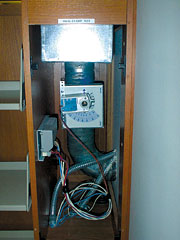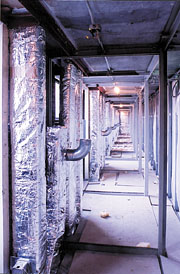
Widener Library was built in 1915 by Mrs. Eleanor Widener as a gift to Harvard University. The building, which is approximately 300,000 gross sq ft, is dedicated to Mrs. Widener's son and Harvard alumnus, Harry Elkins Widener, a bibliophile and book collector, who perished on the Titanic in 1912. In the center of the building, between the first and second floor, is a memorial room containing Mr. Widener's personal collection of 3,500 rare books.
The stacks, which contain approximately 3.25 million volumes on 10 levels, account for 185,000 gross sq ft and contain 57 miles of bookshelves. This provides very efficient storage for the main collection, while allowing good user access to virtually every volume. The unique, self-supporting iron and steel structure of the stacks, manufactured by the Snead and Company Iron Works, also provides structural support for the third floor, which is located directly above the stack area.
Extremely low floor-to-floor clearances and the structural infeasibility of altering the configuration of the stack structure without dismantling almost the entire building were two of the challenges that the design team faced in integrating new engineered systems into this historic building.
Even more challenging was designing the renovation to permit continuous access to the collection during construction. In each reopened floor, modern, efficient systems carefully regulating temperature, humidity, air quality, and ultraviolet light as well as a quick-responding fire protection system has been installed to protect the books.
The primary objective of the renovation was to provide for the long-term preservation of one of the largest book collections in the world. To that end, the following project goals were established:
- Protect the building occupants, building, and collections from smoke and fire damage;
- Achieve appropriate temperature control for the long-term preservation of the collections;
- Replace outdated wiring and electrical system components; and
- Provide control for all ultraviolet radiation.
After the library established the project goals, an environmental control feasibility study was undertaken to identify and explore the options for meeting them. This exploration continued into the design process where, through close collaboration between architects, engineers, the construction manager, and librarians, solutions were developed that met project goals.

Designing an Environment for the Collection
The original mechanical systems consisted of perimeter steam radiators and a simple once-through ventilation system. The long-since abandoned mechanical ventilation system used to supply fresh air from the open courtyards at the lowest level of the stacks and exhaust it from the top level.The system relied on open toe spaces at the bottom of each shelving range to allow the air to flow freely between levels. Operable windows along the exterior of the building and into the central courtyards were often opened to provide summer cooling. The result was an environment with large swings in temperature and humidity, both ultimately damaging to the collection and uncomfortable for building occupants.
Books deteriorate faster in environments with inadequate temperature and humidity controls. Variations in rh cause size and shape changes in all moisture-containing materials such as paper. High humidity levels cause corrosion, warping, and bacterial growth while low humidity levels cause drying, shrinking, and brittleness. Variations in temperature also cause dimensional change and stress, accelerating the aging process.
Inadequately filtered air also leads to deterioration. Particulates in the air will collect on exposed surfaces and can form a film that is abrasive and difficult to remove. Gaseous pollution in the air can promote discoloration and deterioration. Ozone, sulfur dioxide, and nitrogen oxides accelerate oxidation and can cause tarnishing and acidification, especially in paper products where they are readily absorbed. Outside air used for ventilation purposes is not the only source of gaseous pollution; offgassing of new materials also poses a threat.
Harvard University established design criteria in consultation with a conservation environment consultant to provide for the protection and preservation of the collection and the comfort of the occupants. These criteria include the following guidelines:
It is projected that by meeting these criteria, the life expectancy of the collection will more than double.
HVAC Systems
The new HVAC system serving the stack areas is an all-air system designed to operate 24 hours a day, year-round. The air-handling systems consist of both outside and stack recirculating AHUs. Chilled water for cooling is provided from the campus chilled water system. Hot water for reheating is generated by steam-to-water heat exchangers using the campus' central steam.Outside air required for ventilation and pressurization of the stacks is brought in at the roof level to an existing penthouse mechanical room. The mechanical room had previously been used to house the exhaust fans of the original ventilation system. Two 9,000-cfm outside AHUs with gas-fired desiccant dehumidifiers pretreat and dehumidify the air before it is mixed with the return air of the stack recirculation air-handling systems.
Each outside AHU consists of 30% prefilters, 85% final filters, a hot water preheat coil, and a chilled water cooling coil. The chilled water coils use the 45 degrees campus chilled water to precool and dehumidify the air to approximately 53 degrees. The dehumidifiers use a rotary wheel silica gel desiccant capable of removing up to 0.5 gal of water from the air per minute at peak loads. The pretreated outside air is dried to 24 grains/lb and provides all of the dehumidification capacity required to maintain the stacks at a maximum rh level of 40%.
At the stack AHUs, located within the new courtyard mechanical rooms, the pretreated outside air and return air from all of the stack levels are filtered and humidified as required. The 50,000-cfm custom AHUs use 30% and 95% particulate filters and a vertical tube gas filtration system to remove particulates and gaseous pollutants such as sulfur dioxide, nitrogen oxide, and ozone. The gas media is a combination of carbon and potassium permanganate with a projected life of approximately two years.
The vertical tube system offers better efficacy (no bypass air) and easier maintenance in systems of this size. The gas media is replaced by bulk loading and unloading of the media. (New media is added at the top through quick-open hatches, spent media is vacuumed from the outlet ports at the bottom of the unit.)
Since the campus central steam is chemically treated, a steam-to-steam heat exchanger was provided to generate 'clean' low-pressure steam for humidification. Steam humidifiers are used in each of the stack AHUs to maintain a minimum rh level of 30% within the space.
Each stack AHU serves an all-air system made up of six zones with individual reheating and recooling coils that serve the stack shelving areas, window transmission loads, and perimeter variable loads, respectively. All new mechanical equipment and associated piping is located within the new mechanical rooms.
The constant-volume shelving supply air system distributes air to every stack aisle to provide good air motion and circulation throughout the stack areas and to handle the small lighting and occupant loads that may exist. The temperature of the air is close to room temperature (60 degrees to 68 degrees).
Constant-volume window supply air system distributes air at the perimeter windows and is designed to handle the exterior heat loss and heat gain associated with the building envelope. The VAV carrel supply air system distributes air at the perimeter carrels through cabinet space carefully integrated into the study carrels. The cabinet is designed to house the VAV damper and actuator assembly, and a discharge plenum. The VAV supply air is designed to handle the variable solar loads of the windows and miscellaneous people and equipment loads associated with the study carrels.

Fire Protection and Electrical Systems
In addition to the installation of the new HVAC systems, the project goals included other improvements to the stack areas such as life safety, fire detection, automatic sprinklers, electrical wiring and lighting upgrades, and ultraviolet radiation control.The building's egress system was upgraded with improvements including new egress stairs, correction of dead end corridors, exit signs, and emergency lighting. A fire-rated wall was built between the east and west stacks so that they could be separated into two fire areas.
Within each fire area, all openings between floors were provided with smoke separation. This included the closing of toe spaces below the shelves, as well as closing stairs and other openings that were abundant in the stacks.
The outdated fire detection system that serviced limited areas of the building was replaced by an air aspiration smoke detection system. This system was chosen for its ability to provide a quick response to events. Likewise, a wet sprinkler system was provided throughout the stacks to provide maximum protection to the collection from fire. A wet system was chosen rather than a dry one because response time was deemed the highest priority. Wet books can be restored, but burnt or smoke damaged ones cannot.
Electrical upgrades included replacing outdated wiring and electrical system components. Prior to the renovation, much of the branch circuit wiring was over 60 years old, and stack lighting was provided by incandescent A-type lamps mounted in exposed fixtures much like one would find in the closets of houses. Controls consisted of switches at each end of the aisles. It was estimated that 10% of the stack ranges had lights on when no users were present, which both wasted energy and subjected the collections to continuous light exposure.
All wiring and incandescent fixtures have been replaced. Light levels were designed to provide a balance between the need for adequate lighting levels for users and the need to have as little light as possible in the stacks in order to preserve the collection. The following criteria were chosen to achieve this: maximum, 50 footcandles (ftc); minimum, 2 ftc; overall average, 10 to 20 ftc.
To prevent fixtures from being continually left on, passive infrared motion sensors were installed so that lights automatically turn on when patrons enter an aisle and turn off after the preset time of five minutes. It was estimated that the new lighting system represents a reduction on the connected lighting load and energy usage of approximately 40%.
Since fluorescent lamps were provided, sleeves were used to protect the collections from UV radiation. In addition to protecting the stacks from artificial sources of UV radiation, a sun-control window film was added on all exterior windows.
The Key to Distribution: a/e Integration
Together, architects and engineers were confronted with the challenge of integrating new building systems into an existing structure with limited distribution space while minimizing the loss of bookshelves. With the exception of one floor, all stack levels have a floor-to-floor dimension of 6 ft, 8 in. to 7 ft. This tight spacing, with only a 1.25-in. piece of marble separating floors, made significant horizontal distribution difficult.Steel columns are located in the bookshelves at 42 in. on center, with only 27 in. separating stacks. Forty-four-inch-thick masonry piers surrounding the stacks support the roof and provide lateral support for the system. Spaces between the piers are infilled with double-glazed, insulated glass windows that were installed in a 1987 replacement campaign.
While the infilling of the courtyards provided space to house the new mechanical equipment, there was still the challenge of how to distribute the air within the stacks themselves. Because of the limited floor-to-floor heights within the stacks, all of the significant horizontal distribution has to occur at the lowest level. This is possible because this level has an additional 36 in. of space above the bookshelves where the original ventilation ductwork was installed.
The HVAC supply systems carefully work their way through the building, starting in the courtyard mechanical rooms. Once inside of the lowest level of stacks, the primary constant-volume supply air ducts begin to rise within the book stacks. Bookshelves were removed from every fourth row of stacks so that new vertical duct risers could be added to deliver air to each aisle. Each riser fits within the 42 in. of space available between the structural steel.
At each stack level, horizontal distribution is limited to ducts with a depth of 3 in. to fit within the depth of the existing steel beams. Location of the supply grilles had to be closely coordinated with the new lighting and sprinkler layouts. Even with these limitations, supply air reaches every row of books.
Ducts supplying air for both the constant-volume window supply air and perimeter VAV supply air ductwork make their way in the lowest stack level to the perimeter piers where they are subdivided and begin their ascent through the stacks. Existing plaster and terracotta were stripped off of the piers so that ductwork could fit in the remaining space between the bricks and steel of the structure.
On the south side of the stacks, the original construction varied and some structural steel was modified. To fit within the available space, the VAV supply air is divided into four separate risers, with sizes ranging from 10- by 5-in. to 14- by 5-in. Supply air is delivered at each stack level within a cabinet space that was carefully integrated into the study carrel design. The cabinet is designed to house the VAV damper, actuator assembly, and a discharge plenum.
The 8- by 6-in. window supply air risers are also located at the perimeter piers within cavity spaces that were originally occupied by the steam radiator pipe risers. Linear diffusers are used to supply air at all of the window locations. Only with close coordination between the HVAC engineer and architect could the proper sizing and arrangement of the ductwork be achieved.
Together, architects and engineers also tackled the problem of providing a pathway for the return air. In the end, the architects provided the idea for a system that could be installed without the loss of nearly any bookshelves. This was achieved by constructing plenums within a centrally located, existing shaft containing an undersized elevator, nonfunctional dumbwaiter, and stair. New stairs and elevators were built in the courtyards to serve the stacks.
The new HVAC, fire protection, and electrical systems as well as the building code required egress improvements were integrated into the building with a loss of only 3.9% of shelving space (only 12,000 linear ft of more than 300,000 linear ft of shelving). Given the magnitude of the upgrades and the limiting existing conditions, this was a remarkably low number to lose and provide for the long-term preservation of the collections.

Keeping the Library Operational
Perhaps one of the most challenging aspects of preserving the books was keeping the collections fully accessible during renovation. Despite the $40 million construction project surrounding them, all the books remained accessible to patrons from around the world who visited the library.Keeping the books accessible started with the idea of containing construction to one half-stack at a time and understanding that success laid in the details. Discussions with the construction manager during the design process, combined with mockups, enabled the engineers and architects to develop solutions that could be implemented on a floor-by-floor basis that contained construction, as well as dust and debris, to one level.
Prior to the start of construction, Harvard College Library culled and reorganized the collection by removing selected material to the Harvard Depository (a media storage and retrieval facility) so that after consolidation, the lowest level of the stacks could be emptied.
When construction was completed on the first of the 20 half-stacks, materials from the third half-stack to be renovated were moved into the finished level while the second half-stack was being renovated. This process of 'leapfrogging' provided a constant flow of construction, and book moves could be choreographed while both protecting and providing access to the books. Each of the 20 half-stacks were moved and renovated on a six-week schedule, and the entire project was completed on time.ES
